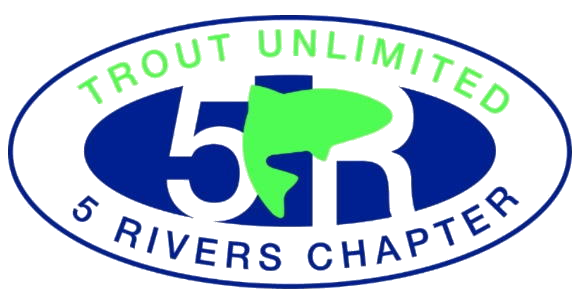primary coldwater fish in our region
Source: Joe Tomelleri©
Brown Trout
The original range of the Brown Trout reaches from northern Norway and the White Sea tributaries of Russia south to the Atlas Mountains of North Africa.
Brown Trout are a non-native species that were introduced to Colorado in the 1890’s.
Brown Trout are not considered to be endangered. However, individual populations can suffer from habitat degradation and poor land management and water management practices.
Browns prefer a water temperature range of 56-66 degrees F. They can tolerate warmer water than many other trout, but still need cold oxygen-rich water to thrive.
Spawning season generally begins in October and runs into December.
After growing to a length of 12-inches or so, Browns often develop different eating habits. In addition to their regular rations of aquatic insects, they begin to take larger prey such as minnows, small trout, crustaceans, and even mice. Although larger browns will rise to the surface for hatching insects or grasshoppers, the majority of their forage is taken beneath the surface.
Sources: USDA Forest Service; Coloradooutdoorsmag.com
Local Brown Trout Rivers and Streams
Animas River
Dolores River
Florida River
Hermosa Creek
Piedra River
Pine River
Rio Grande
San Juan River
San Miguel
rainbow Trout
Source: Joe Tomelleri©
The native range of the rainbow trout is a fairly narrow band along the western coast of North America, from the southern tributaries of Alaska’s Kuskokwim River in the north to the mountains of northern Mexico in the south. On the other side of the Pacific, the range includes the Kamchatka Peninsula and surrounding waters
Rainbow trout prefer streams with gravel bottoms and natural cover. They will hold in faster currents than brown trout, including riffles and heavy pocket water.
Spawning season for rainbow trout occurs in the spring.
The temperature tolerance of rainbow trout is from 32 to 70 degrees F. Their ideal range is between 55 and 60.
Rainbows do not spawn in lakes, so self-sustaining populations require tributaries with gravelly bottoms for natural reproduction. They always try to return to spawn in the same part of the river that they were hatched.
Rainbow trout are less pisciverous than brown trout, so they are more likely to rise to a dry fly or take a nymph. Even as they grow larger, they continue to feed heavily on bugs.
Source: https://forum.americanexpedition.us; Orvis.com
Local Rainbow Trout Rivers and Streams
Animas River
Cascade Creek
Dolores River
Florida River
Hermosa Creek
Piedra River
Pine River
Rio Grande
San Juan River
San Miguel
Colorado Cutthroat
Source: Joe Tomelleri©
Colorado River Cutthroat (CRC) once inhabited the high-elevation streams and lakes of the Green and Colorado River basins in parts of five states.
CRC currently inhabit somewhere between 11% and 16% of their original range. Non-native species, such as brook, brown, and rainbow trout, have outcompeted the species driving the CRCT from much of its range.
They are spring spawners, although low water temperatures at altitude can push spawning back to as late as July.
The upper reaches of Hermosa Creek serve as a good case study of a CRC recovery program. In the early 1990s, Colorado Parks and Wildlife removed all nonnative species and restocked stocked genetically pure CRC in native habitat without the threat of competition.
They are opportunistic feeders, focusing mostly on aquatic and terrestrial insects. The relative scarcity of food at high altitudes means they often eat in the middle of the day and are not choosy, as well.
Colorado cutthroat can be found west of the Continental Divide
Source: Orvis.com
Local Colorado Cutthroat Rivers and Streams
Cascade Creek
Dolores River and tributaries
East Fork of Hermosa Creek
Hermosa Creek
Lime Creek
Rio Grande Cutthroat
Source: Joe Tomelleri©
The Rio Grande cutthroat trout is native to streams in the Rio Grande Basin inhabiting only about 10-15% of it’s original range in a few areas of southern Colorado and Northern New Mexico.
The Rio Grande Cutthroat (RGC) trout is the Southernmost member of the cutthroat species.
In Colorado, RGC are found east of the Continental Divide.
The historic range of the RGC has been reduced due to drought, water infrastructure and habitat changes, hybridization with rainbow trout and other species of cutthroat trout, and competition from brown trout and brook trout.
Since cutthroat trout are more sensitive to water quality conditions than most other species of fish, they serve as bellwethers for assessing the harmful effects of logging, road-building, mining and energy development on water quality
As a result of ongoing management activities, the range-wide abundance and distribution of RGC trout appear to be stable.
Because of the high mountain environments habitat they live in, they are opportunistic feeders like other cutthroat species.
Source: USDA Forest Service; Orvis.com
brook trout
Source: Joe Tomelleri©
Brook trout were introduced to Colorado in 1872, and are native to Canada and the Eastern U.S.
Brook trout are actually a char, in the same family as lake trout and bull trout.
Brook trout are fall spawners, generally in October and November.
This prolific fish often becomes overpopulated and can out-compete other trout. They are typically found in higher elevation lakes, beaver dams and streams.
In the northern Rocky Mountains, non-native brook trout are considered a significant contributor to the decline of native cutthroat trout in headwater streams.
The brook trout inhabits large and small lakes, rivers, streams, creeks, and spring ponds. They depend on cold, clear, well-oxygenated water of high purity.. Warm summer temperatures and low flow rates can be stressful on brook trout populations.
They are extremely opportunistic and have a diverse diet that includes larval, pupal, and adult forms of aquatic insects (e.g., caddis, stoneflies, mayflies and midges) and adult forms of terrestrial insects that fall into the water.
Source: U.S. Fish and Wildlife Service; Orvis.com; National Wildlife Federation
Local Brook Trout Rivers and Streams
Dolores River
Hermosa Creek
La Plata River






